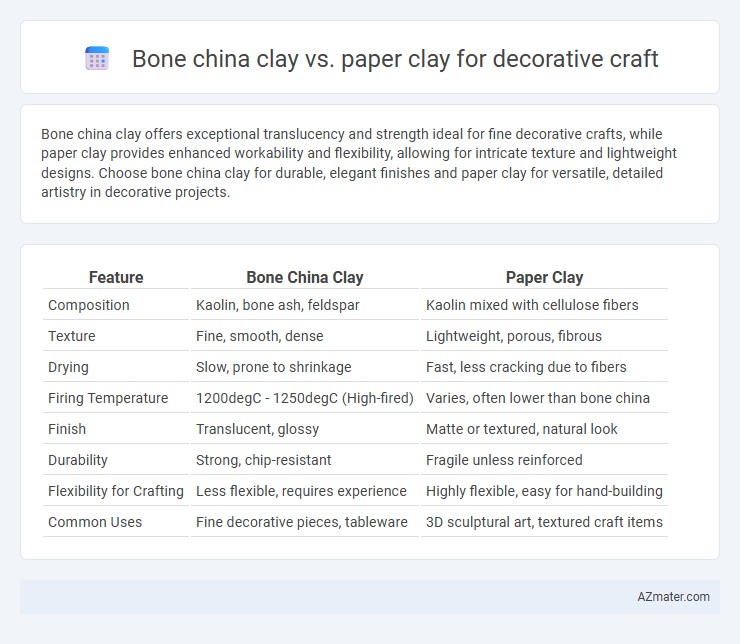Bone china clay offers exceptional translucency and strength ideal for fine decorative crafts, while paper clay provides enhanced workability and flexibility, allowing for intricate texture and lightweight designs. Choose bone china clay for durable, elegant finishes and paper clay for versatile, detailed artistry in decorative projects.
Table of Comparison
| Feature | Bone China Clay | Paper Clay |
|---|---|---|
| Composition | Kaolin, bone ash, feldspar | Kaolin mixed with cellulose fibers |
| Texture | Fine, smooth, dense | Lightweight, porous, fibrous |
| Drying | Slow, prone to shrinkage | Fast, less cracking due to fibers |
| Firing Temperature | 1200degC - 1250degC (High-fired) | Varies, often lower than bone china |
| Finish | Translucent, glossy | Matte or textured, natural look |
| Durability | Strong, chip-resistant | Fragile unless reinforced |
| Flexibility for Crafting | Less flexible, requires experience | Highly flexible, easy for hand-building |
| Common Uses | Fine decorative pieces, tableware | 3D sculptural art, textured craft items |
Introduction to Bone China Clay and Paper Clay
Bone china clay is a refined ceramic material made from bone ash, feldspar, and kaolin, known for its high strength, translucency, and smooth texture, making it ideal for delicate decorative crafts. Paper clay incorporates cellulose fibers into traditional clay, offering enhanced flexibility, reduced shrinkage, and easier sculpting, which benefits artisans creating intricate, lightweight decorations. Both materials provide unique advantages for decorative craft projects, with bone china achieving fine, durable finishes and paper clay allowing greater manipulation and durability during the drying process.
Composition and Material Properties
Bone china clay contains bone ash, feldspar, and kaolin, resulting in a dense, smooth texture with high translucency and strength ideal for fine decorative crafts. Paper clay incorporates cellulose fibers mixed with traditional clays, which enhances flexibility, reduces shrinkage, and allows for lightweight, sculptural designs with increased crack resistance. Both materials offer unique advantages in decorative craft, with bone china prized for its porcelain-like finish and paper clay valued for its workability and durability.
Workability and Handling Differences
Bone china clay offers a smooth, fine texture that allows for intricate detailing and delicate finishes in decorative crafts, making it ideal for precise sculpting and delicate pieces. Paper clay incorporates cellulose fibers, providing increased strength and flexibility, which enhances workability by reducing cracking and enabling easier attachment of parts during handling. While bone china clay requires careful moisture control to prevent brittleness, paper clay's fibrous composition allows for longer working times and better support for complex or larger structures.
Firing Temperatures and Processes
Bone china clay requires high firing temperatures, typically between 1200degC and 1300degC, to achieve its characteristic translucency and strength due to its high kaolin and bone ash content. Paper clay contains cellulose fibers, allowing it to be fired at lower temperatures, usually around 1000degC to 1100degC, which reduces the risk of cracking during the firing process and is ideal for delicate decorative crafts. The firing process for bone china is more demanding and precise, involving multiple stages including bisque and glaze firing, whereas paper clay offers more flexibility with single firing cycles and easier workability during sculpting.
Surface Finish and Texture Comparison
Bone china clay offers a smooth, translucent surface finish with a refined, polished texture ideal for delicate decorative crafts. Paper clay provides a textured, slightly matte finish due to its fiber content, enabling a more handcrafted and rustic appearance. The choice depends on whether a sleek, glossy elegance or a tactile, organic feel is desired for the decorative project.
Strength and Durability in Decorative Crafts
Bone china clay offers superior strength and durability due to its high bone ash content, which creates a dense, vitrified structure ideal for delicate yet long-lasting decorative crafts. Paper clay incorporates cellulose fibers, enhancing its tensile strength and resistance to cracking during drying and firing, making it suitable for intricate and lightweight decorative pieces. While bone china provides a refined, resilient finish, paper clay excels in flexibility and ease of repair, balancing strength with creative versatility.
Color Response and Glazing Results
Bone china clay offers a smooth, porcelain-like finish with excellent color clarity and translucency, enhancing vibrant hues in decorative crafts. Paper clay contains cellulose fibers, providing a matte surface that may absorb glazes differently, often resulting in richer textures but less glossy finishes compared to bone china. Color response in bone china is typically sharper and more vivid, while paper clay's glazing results emphasize depth and tactile variation.
Suitability for Intricate Designs
Bone china clay offers exceptional smoothness and plasticity, making it ideal for achieving fine details and intricate designs in decorative crafts. Paper clay contains cellulose fibers that provide added strength and flexibility, enhancing the ability to sculpt complex shapes without cracking during drying. Both clays support delicate craftsmanship, but bone china excels in detailed surface texture, while paper clay better sustains structural integrity in elaborate forms.
Environmental and Health Considerations
Bone china clay contains bone ash, which is derived from animal sources, raising ethical concerns and potential allergen risks, while its firing process demands high energy consumption. Paper clay incorporates cellulose fibers, often sourced from recycled paper, enhancing sustainability and reducing environmental impact through lower firing temperatures. Health-wise, paper clay produces less dust and fumes, making it safer for indoor crafting environments compared to bone china clay's potential exposure to bone dust and higher kiln emissions.
Choosing the Right Clay for Your Decorative Projects
Bone china clay offers a fine, translucent finish ideal for intricate decorative crafts requiring delicate detailing and a porcelain-like appearance. Paper clay, infused with cellulose fibers, provides enhanced strength and flexibility, making it perfect for larger, sculptural projects that benefit from reduced cracking and easier joining. Selecting the right clay depends on the project's durability needs, surface texture preference, and firing capabilities.

Infographic: Bone china clay vs Paper clay for Decorative craft
 azmater.com
azmater.com